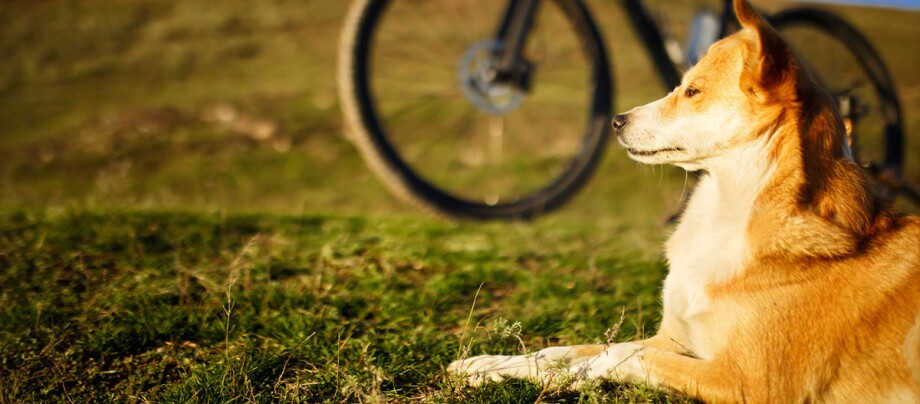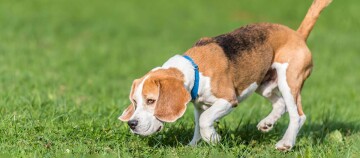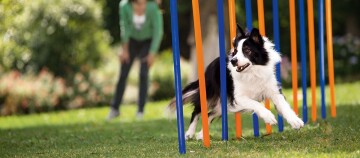Cycling with Your Dog - How to Train Your Dog to Follow Your Bike
07.10.2022 - Reading time: 5 minutes

Going on a bike ride with your dog is a fun activity, of course, your dog must be physically capable of keeping up. It challenges your dog and gives them plenty of exercise. However, you have to train your dog to run properly with your bike. There are certain things you have to take into consideration. Find tips on how to train your dog to follow your bike here.
Cycling with a dog – what to bear in mind
Your dog may officially travel alongside you as you cycle. Of course, care must be taken not to endanger road traffic and other road users. Always keep your dog on your right side to protect it from passing cars! It is not compulsory to keep the dog on a lead, but it is of course preferable to do so in traffic.
You should never attach the dog’s lead to the handlebars, as this puts you at particular risk if your dog suddenly lunges. Due to the dog’s jerky movement, you quickly run the risk of falling and thus endangering yourself, the dog and other road users. The best thing to do when cycling with a dog is to use a special lead and bicycle holder, the so-called sprinter, or (if necessary) to hold the leash in your hand. In the forest or along country lanes, your four-legged friend is also allowed to run alongside your bike without a lead – provided, of course, that it comes when called.
Important questions about cycling with your four-legged friend – for your dog’s sake
How long is my dog able to run with me? How fast or slow do I need to go? The answers must take several factors into account.
Important questions about cycling with a dog
- As a general rule, only adult, healthy dogs are allowed to run alongside bicycles. In particular, animals with joint problems or cardiovascular diseases should never run alongside bicycles.
- Puppies and young dogs up to the age of 15 to 18 months should not run alongside a bike at all! But they can start so-called dry runs with you (see below).
- Likewise, older dogs and heavy breeds should not run alongside bicycles. Instead, think about protecting their already heavily loaded or old joints!
- With very small dogs, the question is whether they can even keep up the pace. Keep in mind that the risk of heat stroke is very high for these dogs.
- Some breeds of dog are not suitable for running alongside a bike – for example Bulldogs. If in doubt, it is best to consult your vet.
Of course, your dog’s individual fitness and the weather also play a role. Just as it will be difficult for you to go jogging on a sunny summers day at 30 °C, your four-legged companion will not enjoy running alongside your bike in the heat. On longer bike rides (in any weather), make sure your dog has enough fresh water and takes enough breaks. You should also refrain from letting your dog run alongside your bike if he is overweight. There is a risk of circulatory collapse and heart failure (heat stroke).
Warm-up: initial dry runs for cycling with a dog
Take a three to five metre long lead and practise walking your dog. If it tries to run ahead, change direction until it walks beside you again. Praise your dog for this behaviour. As soon as your dog has mastered walking alongside you, incorporate commands such as “stop” and “go” into the exercise. This way your dog can be directed without a lead later on.
Off we go: running next to the bike
Now get your dog used to the bike. Some dogs react with avoidance behaviour: they avoid the bike when they see it for the first time or when the bike approaches. Now repeat the first exercise by pushing the bike and letting the dog walk beside you. You can now also start to get your dog used to the bike holder or sprinter. If this works well too, do the first practice laps in a car park without any traffic. Only then can you start: the first small tracks in the park are ideal for practising. To turn your pet into a pro, always tell it to change direction with the commands “right” or “left”.
You should also consider this – avoiding stress
Asphalt and gravel roads put a lot of strain on your dog’s joints and paws in the long run. In summer, asphalt heats up so much that it can burn your dog’s paws. Pointed stones, broken glass and gravel can cause cracking. After every bike ride, check your dog’s paws and care for the paw pads so that they remain soft and supple and do not crack. This is especially important for “cycling” dogs.
Basket and trailer: variants for small, weak or large dogs
There are special bicycle baskets for small dogs weighing up to five kilograms or so. Short legs mean great body strain and relative lack of pace. It is hardly possible for small dogs to keep up with a bicycle over a long period of time. If you still want to take your dog along on a bicycle tour, a bicycle basket is a very good option. There are baskets for handlebars or luggage racks. A handlebar basket has the advantage that you can always keep an eye on your dog. The basket should be lockable with a grille so that only the dog’s head can peek out. This prevents the dog from jumping out. For all-weather riders, there are dog baskets with a rain cover. A variant for larger, heavy or handicapped dogs is the bicycle trailer. The main thing to consider here is your own physical condition. A Great Dane can weigh a good 100 kilograms together with the trailer.


